
MXL Revelation – First Listen
Wednesday, February 17th, 2010 | by matthew mcglynn
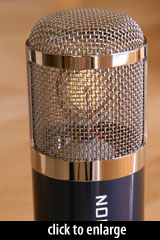 Thanks to our friends at MXL, we received an early production sample of the Revelation, MXL’s new flagship microphone.
Thanks to our friends at MXL, we received an early production sample of the Revelation, MXL’s new flagship microphone.
We’ve had a chance to hear it on acoustic guitar, vocals, and drums. We have exclusive photos and audio samples below.
The MXL Revelation is a multipattern tube condenser. It follows MXL’s successful Genesis tube mic, which had a fixed-cardioid response and was remarkable for using a vintage Mullard 12AX7 tube. 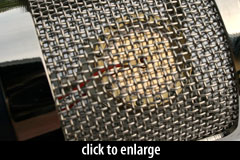 These mics are, to my mind, evidence that MXL is going after the professional market, with distinctive and classy designs. I hope this trend continues.
These mics are, to my mind, evidence that MXL is going after the professional market, with distinctive and classy designs. I hope this trend continues.
The Revelation uses the same K67-style capsule as the Genesis, albeit with both front and back diaphragms being wired to allow for variable pattern control. The pattern control switch on the power supply can be swept smoothly from Omni to Figure-8 with no detents and no switching noise.
Note the single-layer headbasket — clearly, MXL is watching the modders for cues about how to improve their products. You’ll want to use a pop filter on this mic if someone is singing at it.
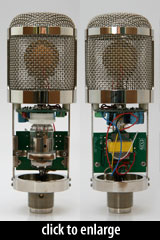 The Revelation does not use the Mullard tube from the Genesis (a dual-triode 12AT7). The Revelation’s circuit is a different design, and uses an EF86 pentode from Electro-Harmonix.
The Revelation does not use the Mullard tube from the Genesis (a dual-triode 12AT7). The Revelation’s circuit is a different design, and uses an EF86 pentode from Electro-Harmonix.
The Revelation’s output circuit uses a transformer — again, unlike the Genesis, which had a transformerless output.
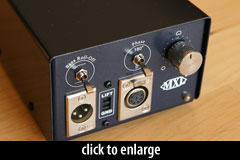 The power supply provides the aforementioned variable pattern control knob, plus a 180° phase switch and a high-pass filter. On the rear of the PSU is a power switch, a standard IEC C14 jack for the power cord, a voltage switch (115V/230V), and a fuse.
The power supply provides the aforementioned variable pattern control knob, plus a 180° phase switch and a high-pass filter. On the rear of the PSU is a power switch, a standard IEC C14 jack for the power cord, a voltage switch (115V/230V), and a fuse.
When the power is switched on, the power switch glows red, and a red LED on the front panel lights up.
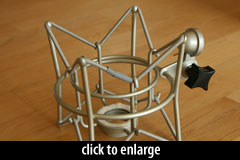 The included shockmount is nicely made. It is a standard “birdcage” style. We had some trouble getting the microphone firmly into the shockmount at first; the threads seemed to bind after about a quarter-turn. With so few threads engaged, I would not have wanted to invert the mic. After a few uses, however, the felt padding of the shockmount compressed somewhat, enabling the mic to be firmly installed and inverted without risk.
The included shockmount is nicely made. It is a standard “birdcage” style. We had some trouble getting the microphone firmly into the shockmount at first; the threads seemed to bind after about a quarter-turn. With so few threads engaged, I would not have wanted to invert the mic. After a few uses, however, the felt padding of the shockmount compressed somewhat, enabling the mic to be firmly installed and inverted without risk.
Spare elastics for the shockmount are provided.
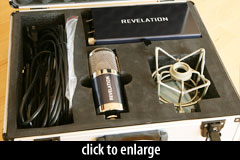 The mic ships in MXL’s standard aluminum flight case. Foam cutouts house the power supply, shockmount, cables, and the microphone itself.
The mic ships in MXL’s standard aluminum flight case. Foam cutouts house the power supply, shockmount, cables, and the microphone itself.
MXL includes two high-quality cables for the microphone — a Mogami Neglex 7-pin cable to power the mic and carry the audio back to the PSU, and a 3-pin XLR Mogami 2552 cable to plug into the preamp.
I am glad to see that there is no wooden storage box for the microphone, as these add weight, bulk, and cost without (in my opinion) adding a lot of value. I store tube mics in their flight cases anyway.
If you leave your mics on stands, you’ll wish the Revelation came with a dust cover — a more-useful accessory than a wooden box, in my opinion. You’ll need to bust out the Crown Royal bags like our friends at Stepbridge.
So, what does the Revelation sound like? I’ve posted samples of two different acoustic guitars below, plus drums and vocals. We expect to post a fuller review, with comparisons of the Revelation to competitive tube mics, in a subsequent article.
Acoustic Guitar
 I recorded two local acoustic players, Seth Dixon and Peter Bergquist. The mic was set to Cardioid, positioned around the 12th fret (despite what you may see in the photos here), and had the pad, phase, and rolloff disengaged.
I recorded two local acoustic players, Seth Dixon and Peter Bergquist. The mic was set to Cardioid, positioned around the 12th fret (despite what you may see in the photos here), and had the pad, phase, and rolloff disengaged.
Peter’s Guild guitar was dark-sounding in the large room. The acoustic sound verged on boomy. The Revelation has no pronounced HF boost in its published frequency-response chart, but all the same the mic brought some much-needed sparkle to the track.
[audio:http://recordinghacks.com/wp-content/uploads/2010/02/rev_pb_guit.mp3]
 Seth’s Alvarez guitar had a more balanced tone acoustically. The Revelation captured a nice, clear tone. The HF sparkle is there, but is not overbearing.
Seth’s Alvarez guitar had a more balanced tone acoustically. The Revelation captured a nice, clear tone. The HF sparkle is there, but is not overbearing.
We’d been tracking this guitar through solid-state mics all afternoon. When we switched to the Revelation, the tone of the mic was immediately apparent. This mic has a lot of personality. The tube-and-transformer sound was beautiful — warm, lush, present and inviting. It made me wish we’d used the Revelation for tracking instead.
[audio:http://recordinghacks.com/wp-content/uploads/2010/02/rev_seth_guit.mp3]
Vocals
Seth Dixon recorded a short vocal sample, just to give an idea of the mic’s sound as a vocal mic. We used a metal-mesh Stedman pop filter in front of the mic, and a RealTraps “Portable Vocal Booth” (review coming soon) behind, and got a strong, intimate vocal sound with no fussing around.
[audio:http://recordinghacks.com/wp-content/uploads/2010/02/rev_seth_vox.mp3]Drums
I think the Revelation is a kick-ass drum overhead microphone.
At 10 mV/Pa, it has relatively low sensitivity for a large-diaphragm tube mic. Most such mics are rated at 15–20mV/Pa, and therefore need less preamp gain for a given signal level.
But this is no problem for loud sources, like an acoustic drum kit. The mic has plenty of headroom; I was able to use the Revelation without the pad engaged.
My drum kit sounded great through this mic. The toms were full and round, and retained plenty of snap. Cymbals were bright without being harsh. A single Revelation in Cardioid gave me a very nice picture of the drum kit.
[audio:http://recordinghacks.com/wp-content/uploads/2010/02/rev_oh_cardioid.mp3]
[audio:http://recordinghacks.com/wp-content/uploads/2010/02/rev_oh_toms_card.mp3]
Cardioid may be the popular choice for drum overheads, but the Revelation offers an infinite variety of pattern options. I can dial up more room sound in Omni, or dry it out in Hypercardioid.
For the next test, I played the drums with one hand while sweeping the pattern from Omni to Figure-8 with the other. At the end of every 2nd bar, I turned the pattern-control knob approximately 1/5 of the way around. When you hear a drum fill in the middle of the clip, the mic is in Cardioid mode.
[audio:http://recordinghacks.com/wp-content/uploads/2010/02/rev_oh_sweep.mp3]
You’ll hear a few distinct changes in tone. In Omni, the drums are big, boomy and close. Over the next 6-8 bars, they get farther away and perceptively smaller as the low-frequency room resonance drops in volume. After Cardioid, as the front pickup pattern narrows to Hyper, the snare jumps in prominence — because the mic capsule is pointing at it. Finally, as the rear lobe of the mic’s pickup pattern grows, some of that kick-drum resonance comes back into the mix, although less than in Omni.
Multipattern overhead mics let you tune the room sound. This is not something that can be done “in the mix,” nor via outboard gear. If your room sounds good, and that sound is appropriate for the song, dial up Omni. If the room sound isn’t so good, attenuate it with a tighter pickup pattern.
The Revelation does well in this application because there is no switching noise or delay as the pattern dial is manipulated. You could actually change patterns within a song, if that’s what the music called for. (But I’d recommend having someone else turn the knob.)
Gotchas
As noted above, the  MXL Revelation (like its predecessor, the Genesis) has somewhat low sensitivity for a mic of this class. At the same time, its self-noise is moderately high; 18dBA puts it among the noisiest third of the large-diaphragm tube mics we have data for.
MXL Revelation (like its predecessor, the Genesis) has somewhat low sensitivity for a mic of this class. At the same time, its self-noise is moderately high; 18dBA puts it among the noisiest third of the large-diaphragm tube mics we have data for.
The combination means the Revelation is unlikely to be appropriate for distant miking or quiet acoustic instruments. Or, especially, for distant miking of quiet acoustic instruments.
For example, we tried the Revelation on a nylon-string classical guitar, at a distance of about three feet. With its gain matched to a first-generation Studio Projects B1 (solid-state LDC; 20 mV/Pa; 12 dBA) and an sE Gemini II (dual-tube LDC; 12.6 mV/Pa; 12 dBA), the Revelation’s higher noise floor was easily heard. The guitar sounded great through the Revelation, but the noise killed the ambience of this isolated, quiet instrument.
For steel-string acoustics, vocals, drums, horns, etc., self-noise of 18dBA is a non-issue. For close-miked strings, again, no problem. For a distant choir, or a distant anything, I’d reach for a mic with higher output and lower noise.
That caveat aside, I’ve enjoyed the Revelation quite a bit. It sounded good on just about everything we tried it on. It’s warm without being thick, and bright without being jangly. So far, so good. We’ll keep checking it out here, and will post a fuller review and comparison soon. If you have any favorite tube-mic applications you’d like to hear the Revelation on, leave a comment below and we’ll try to work your request into the test cycle.
Revelation Sale Pricing and Rebates
The MXL Revelation profile in the Microphone Database contains more technical details about the mic, and links to the best available prices for the mic. (The mic database provides comparison-shopping info for hundreds of microphones, with the best prices on mics, bundles, and selected accessories (selected by me) updated daily.)
See also the Microphone Rebates page for a Summer-2010 rebate on the Revelation.
Posted in Microphones | 7 Comments »

Dan Evans
February 22nd, 2010 at 9:38 pm
Not sure if you’ve used this yet, but I put the Alesis AM11 (based on the Groovetubes GT55) AM11 on a acoustic, electric (reggae chucks mostly), and vocals and it all sounded beatiful. Check it out
Chris Reed
March 21st, 2010 at 8:03 pm
I am a user and fan of the MXL Genesis. I am also a big user and fan of M-S stereo recording. I am very interested in this mic as the “figure 8” mic over the top of my Genesis as the cardioid “M” mic. Especially interested as to how it would sound as a stereo room mic set up for drum sounds.
Thanks!
Tristan dolce
June 23rd, 2010 at 9:00 am
I’d love to hear the revelation on piano!! An upright!
tania84
January 15th, 2011 at 9:09 pm
Note the single-layer headbasket
Peter
July 17th, 2015 at 4:41 am
Thanks for the review. The Revelation I received actually does have pattern switching noise and delay. The delay is not so pronounced if slowly going counterclockwise from omni to figure 8. I going faster clockwise and then backing off near figure 8 there is a moderately loud static noise. Going anywhere on the pattern selector counter-clockwise either from figure 8 to cardiod or cardiod to omni results in about a 20 second delay before the mic became active again. MXL says this is normal. Another review I saw commented on a few seconds delay while the capsule charges back up. Curious why your’s did not exhibit the same,.
Peter
July 17th, 2015 at 4:43 am
Actually I meant to say The delay is not so pronounced if slowly going clockwise from omni to figure 8.
Daniel Weldn
January 31st, 2017 at 6:56 pm
I just bought an MXL Revelation and immediately swapped out the tube as my mic had pretty high self noise. The tube also low end microphonics which I thought was body resonance! I first tried a Telefunken E80F in it, which dropped the noise floor quite a bit, and really cleaned up some lower mid mud I was experiencing. The only downside is the tube is longer and thinner so I couldn’t use the internal tube holder. And then I found a mint NOS EICO EF86 (rebranded Mulllard) which also was quite a bit quieter than the stock tube, and it sounded great, tight end like the E80F, but a more rich high end! And with just this tube swap this mic came alive! And the Eico firt perfectly in the internal tube holder!